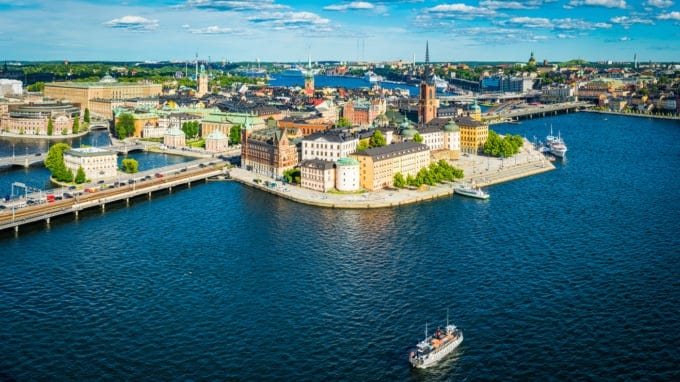VOL 62: Capitalism and Socialism: Which Is Better?
Capitalism and socialism are two major economic systems that have been debated for centuries. Learn about the key differences between these systems and how they have shaped the world we live in today.

Today at a Glance
SwedenSocialism and CapitalismCuba; an extreme version of SocialismSocialist vs Capitalist CountriesSocialism failed worldwideCapitalism: The dominant world economic systemDoes society become more socialist or capitalist without intervention?Conclusion
Quote of The Week
“There is talk of the failure of socialism, and where is the success of capitalism in Africa, Asia, and in Latin America?”
— — —
Fidel Castro
Sweden
We're all familiar with Sweden, right? That prosperous Nordic nation to the north
Sweden is a wealthy nation today, but it wasn't always this way. In the 1970s, 1980s, and 1990s, Sweden was one of the slowest-growing European nations. This was due in part to the fact that Sweden was a socialist state during this period. They were not as hardcore as the USSR, but the government ran most industries in the nation, which stifled innovation and competition.

In the 1990s, Sweden began to implement a series of reforms that reduced the size of the welfare state and privatized many industries. These reforms led to a period of rapid economic growth, and Sweden is now one of the wealthiest nations in the world.
Some people argue that Sweden's success is a testament to the power of socialism. They point to the fact that Sweden was able to achieve high levels of social welfare and economic growth at the same time. However, others argue that Sweden's success is due to its embrace of capitalism. They point to the fact that the reforms of the 1990s led to a period of rapid economic growth.
Ultimately, the question of whether Sweden's success is due to socialism or capitalism is a complex one. There is no doubt that Sweden's welfare state played a role in its success, but it is also clear that the reforms of the 1990s were also important. So it is likely that both socialism and capitalism played a role in Sweden's economic success.
Socialism and Capitalism
Socialism and capitalism are two economic systems that exist on a spectrum. Socialism is defined by government or community ownership of the means of production, while capitalism is defined by private ownership of the means of production.
At one end of the spectrum is anarcho-capitalism, which is a system in which the private sector owns and controls all aspects of society, including the police, the military, and the government. At the other end of the spectrum is hardcore authoritarian socialism, which is a system in which the government owns and controls all aspects of society (the government owns all the land, runs all the companies, produces all the goods, makes all the laws, and runs the military).
Most countries fall somewhere in between these two extremes. For example, the United States is a capitalist country with a strong welfare state, while Sweden is a socialist country with a strong private sector.
There are pros and cons to both socialism and capitalism. Socialism can lead to greater equality and social welfare, while capitalism can lead to greater innovation and economic growth. Ultimately, the best economic system for a country depends on its specific circumstances.
Cuba; an extreme version of Socialism
Cuba is a good example of an extreme version of socialism. In the past, nearly everyone in Cuba worked for the government. However, in recent years, the government has allowed some private sector activity, such as taxi driving. This has led to a situation where a private taxi driver can make 20–30 times more than a government surgeon.
I believe that society needs some elements of socialism to function properly. For example, socialism can be used to provide:
Unemployment benefits, welfare, food stamps, and health insurance for the poor
Military forces
Police forces
Firefighters and emergency responders
Urban planners
These services are essential for the smooth functioning of society and would be difficult or impossible to provide through the private sector.
However, it is important to note that socialism can also have some negative consequences. For example, it can lead to inefficiency and corruption. It is therefore important to find a balance between socialism and capitalism that maximizes the benefits of both systems.
Socialist vs Capitalist Countries
The question of how much socialism and capitalism a society should have is a complex one that there is no easy answer. The answer will vary depending on the specific circumstances of each country. However, I believe that a healthy society should have a mix of both socialism and capitalism.
Let us examine where nations rank in terms of capitalist vs socialist. 100% represents the entire economy, and I will estimate what percentage is capitalist versus socialist. So a 50/50 state is both capitalist and socialist. Keep in mind that this is a rough hand.
Norway: 60% capitalist 40% socialist
Cuba: 10% capitalist 90% socialist
North Korea: 5% capitalist 95% socialist
South Korea: 70% capitalist 30% socialist
China: 50% capitalist 50% socialist
Note that when China was one of the poorest countries on the planet 40 years ago, it was more like 20% capitalism and 80% socialism. Following the adoption of free-market reforms and unrestricted trade, China's wealth skyrocketed.
USA: 90% capitalist 10% socialist
UK: 70% capitalist 30% socialist
Japan: 70% capitalist 30% socialist
You can notice a pattern here. To some extent, the more capitalist you are, the richer you are. A 70/30 or 80/20 blend is ideal. It has been the most effective for the longest time.
Consider Korea. These are two nations of nearly equal size, one prosperous and the other destitute. This is partly attributable to the fact that one is a staunch socialist state and the other is a modern capitalist state.
Socialism failed worldwide
Socialism has been implemented in many countries around the world, but it has not always been successful.
For example, in Poland, the people voted overwhelmingly to end socialism in 1989. This was due to several factors, including economic stagnation, political repression, and a desire for greater freedom.
Similarly, Hungary, Russia, Kazakhstan, Romania, Belarus, Lithuania, and Sweden have all experienced economic and political problems under socialism. In some cases, these problems have led to the abandonment of socialism altogether
Ultimately, the question of whether socialism is a successful economic system is a complex one that there is no easy answer.
The answer will vary depending on the specific circumstances of each country. However, it is important to remember that there is no single definition of socialism, and the experiences of different countries have varied widely.
Capitalism: The dominant world economic system
Think about it. We can say whatever we want, but we all live in a capitalist society. People who lived in socialist countries overwhelmingly chose to end socialism—that should tell you a lot.
While capitalism has been the dominant economic system in the world for centuries, it is good to note that during that time, the world has seen significant progress in many areas.
For example, life expectancy has increased worldwide, deaths from famine have decreased, deaths from war have decreased, childhood mortality has decreased, deaths from preventable diseases have decreased, poverty rates have decreased, and access to basic things like food and water has increased.
These improvements are due in part to the rapid advancement of technology and science, which has been driven by competition in the capitalist system.
While capitalism has undoubtedly led to progress, it is important to note that it is not a perfect system. There are still many people in the world who live in poverty, and there are still many challenges that need to be addressed, such as climate change and inequality.
However, capitalism has proven to be a more effective system for improving the lives of people than any other system that has been tried.
Here are some of the key features of a capitalist society:
Innovation is rewarded. In a capitalist society, businesses are constantly competing with each other to innovate and create new products and services. This competition drives innovation and leads to new and better products and services for consumers.
Bad companies go out of business while good companies grow. In a capitalist society, businesses that are not efficient or that do not provide good products or services will eventually go out of business. This is because consumers will choose to buy from businesses that offer better products and services.
People are paid based on their worth. In a capitalist society, people are paid based on their skills and abilities. This means that people who are more skilled and who contribute more to the economy will earn more money.
The demands of consumers are met. In a capitalist society, businesses are constantly trying to meet the demands of consumers. This means that consumers have a wide variety of products and services to choose from and that businesses are constantly innovating to create new and better products and services.
These are just some of the key features of a capitalist society. Capitalism is a complex system with both advantages and disadvantages. It is important to weigh the pros and cons of capitalism before deciding whether or not it is the best system for a particular country.
Does society become more socialist or capitalist without intervention?
No, it does not.
If left to its own devices, society tends to become increasingly divided between the haves and the have-nots, with a greater and greater share of wealth concentrated in fewer and fewer hands. This is because the capitalist system rewards those who are already wealthy and powerful, while those who do not have a harder time getting ahead.
The end stage of this process is either a crony capitalist system (best case) or a kleptocracy (worst case). In neither case does society tend towards egalitarian control of resources or free and open markets.
Conclusion
None of these systems are perfect. Each has its own set of challenges and criticisms. However, whether or not these systems can coexist with each other depends on how they are implemented and to what extent.
For example, a capitalist system can be made more equitable by implementing social programs that redistribute wealth and provide a safety net for those who are struggling. A socialist system can be made more efficient by allowing for some private ownership and competition.
Ultimately, the best way to ensure that society is fair and prosperous is to find a balance between these two systems.



